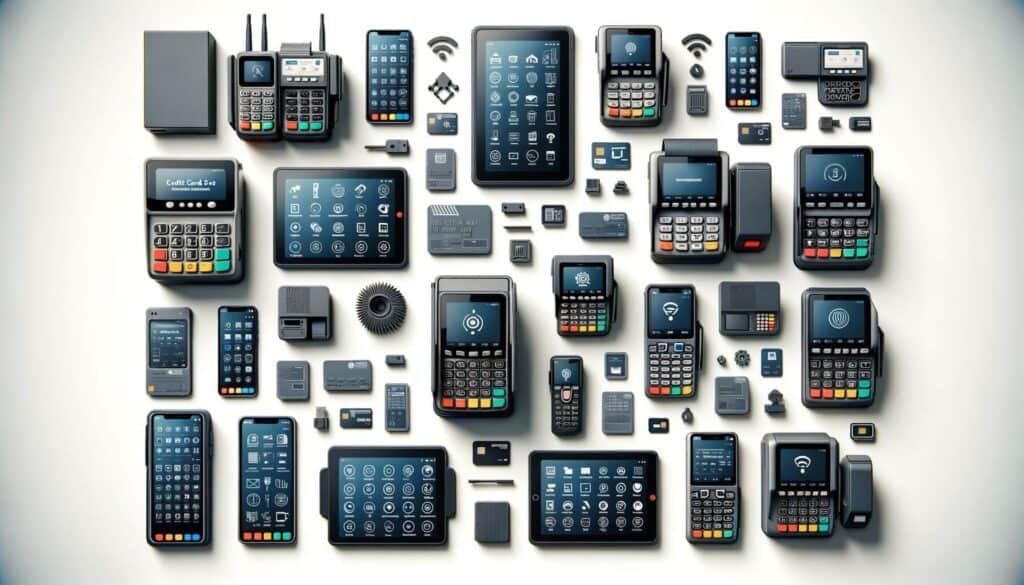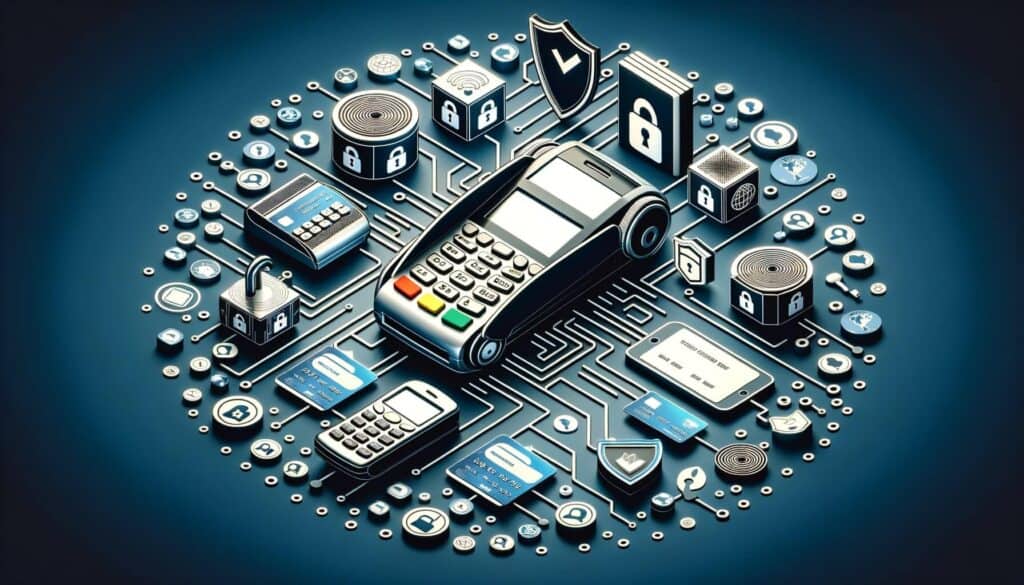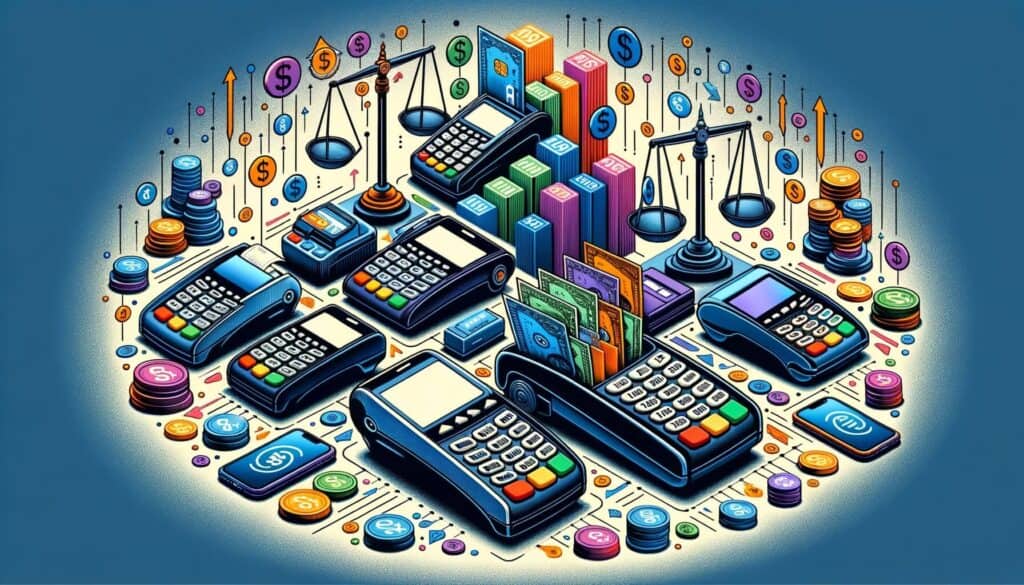
By Amanda Hoglund January 11, 2025
In today’s digital age, credit card payments have become the norm for businesses of all sizes. Whether you run a small retail store or a large e-commerce platform, having the right credit card processing equipment is crucial for smooth and secure transactions. With numerous options available in the market, selecting the right equipment can be a daunting task.
This comprehensive guide will walk you through the factors to consider when choosing credit card processing equipment, the types available, evaluating security features, comparing costs and fees, understanding compatibility and integration, assessing customer support options, and tips for selecting the best provider.
Factors to Consider When Choosing Credit Card Processing Equipment

1. Business Type and Size: The first factor to consider is your business type and size. Different businesses have different needs when it comes to credit card processing equipment. For example, a small retail store may require a simple countertop terminal, while an e-commerce business may need a virtual terminal or payment gateway.
2. Payment Methods: Consider the payment methods you want to accept. Apart from credit and debit cards, some businesses may also want to accept mobile payments or contactless payments like Apple Pay or Google Pay. Ensure that the equipment you choose supports the payment methods you want to offer.
3. Connectivity Options: Evaluate the connectivity options available with the equipment. Traditional terminals may use phone lines or Ethernet connections, while newer options may offer wireless or Bluetooth connectivity. Choose the option that suits your business’s infrastructure and location.
4. Security Features: Security is of utmost importance when it comes to credit card processing. Look for equipment that offers encryption and tokenization to protect sensitive customer data. Additionally, consider equipment that is EMV compliant to protect against fraudulent transactions.
5. Ease of Use: The equipment should be user-friendly and easy to operate for both your staff and customers. Consider factors like screen size, button layout, and intuitive navigation to ensure a smooth payment experience.
6. Scalability: If you anticipate your business growing in the future, choose equipment that can scale with your needs. This will save you from the hassle of replacing equipment as your business expands.
7. Integration with POS Systems: If you already have a point-of-sale (POS) system in place, ensure that the credit card processing equipment integrates seamlessly with it. This will streamline your operations and avoid any compatibility issues.
8. Reporting and Analytics: Look for equipment that provides detailed reporting and analytics features. This will help you track sales, identify trends, and make informed business decisions.
9. Durability and Reliability: Consider the durability and reliability of the equipment. It should be able to withstand the demands of your business and provide consistent performance without frequent breakdowns.
10. Cost: Finally, consider the cost of the equipment. Compare prices from different providers and evaluate the value for money. Remember to also factor in any ongoing fees or charges associated with the equipment.
Types of Credit Card Processing Equipment Available in the Market

1. Countertop Terminals: Countertop terminals are the most common type of credit card processing equipment. They are stationary devices that connect to a phone line or Ethernet and are typically used in retail stores. These terminals have a keypad for entering payment information and a screen for displaying transaction details.
2. Mobile Card Readers: Mobile card readers are small devices that can be attached to a smartphone or tablet. They use a mobile app to process payments and are ideal for businesses that operate on the go, such as food trucks or delivery services.
3. Virtual Terminals: Virtual terminals are web-based applications that allow businesses to process credit card payments through a computer or laptop. They are commonly used for mail or phone orders and do not require any physical equipment.
4. Payment Gateways: Payment gateways are online platforms that enable businesses to accept credit card payments on their website. They securely transmit payment information between the customer, the business, and the payment processor.
5. Point-of-Sale Systems: Point-of-sale (POS) systems combine credit card processing with other business functions like inventory management and sales reporting. They typically include a touchscreen device, cash register, barcode scanner, and receipt printer.
Evaluating the Security Features of Credit Card Processing Equipment

When it comes to credit card processing, security should be a top priority. Here are some key security features to consider when evaluating credit card processing equipment:
1. Encryption: Look for equipment that offers end-to-end encryption. This ensures that sensitive customer data is encrypted from the moment it is entered into the equipment until it reaches the payment processor.
2. Tokenization: Tokenization replaces sensitive cardholder data with a unique token. This token is used for transaction processing, while the actual card data is securely stored by the payment processor. Tokenization adds an extra layer of security and reduces the risk of data breaches.
3. EMV Compliance: EMV (Europay, Mastercard, and Visa) is a global standard for chip-based credit card transactions. EMV-compliant equipment reads the chip on the card instead of relying on the magnetic stripe, making it more secure against counterfeit fraud.
4. PCI DSS Compliance: The Payment Card Industry Data Security Standard (PCI DSS) is a set of security standards that businesses must adhere to when processing credit card payments. Ensure that the equipment you choose is PCI DSS compliant to protect against data breaches and avoid penalties.
5. Fraud Detection and Prevention: Look for equipment that offers built-in fraud detection and prevention features. This can include real-time transaction monitoring, address verification, and CVV verification.
6. Secure Network Connectivity: If the equipment connects to the internet, ensure that it uses secure network protocols like SSL (Secure Sockets Layer) or TLS (Transport Layer Security) to encrypt data during transmission.
7. Physical Security: Consider the physical security features of the equipment. This can include tamper-resistant designs, secure mounting options, and the ability to disable or wipe data in case of theft or loss.
Comparing the Costs and Fees Associated with Different Credit Card Processing Equipment

When selecting credit card processing equipment, it’s important to consider the costs and fees associated with each option. Here are some common costs and fees to compare:
1. Equipment Purchase or Lease: Some equipment may require an upfront purchase, while others offer leasing options. Compare the costs and benefits of purchasing versus leasing to determine the most cost-effective option for your business.
2. Transaction Fees: Transaction fees are charged for each credit card transaction processed. These fees can vary depending on the provider and the type of equipment. Compare transaction fees to ensure you are getting a competitive rate.
3. Monthly Fees: Some providers may charge monthly fees for equipment rental, maintenance, or access to their payment processing platform. Consider these fees when evaluating the overall cost of the equipment.
4. Setup and Installation Fees: Depending on the equipment, there may be setup and installation fees involved. Compare these fees and consider if they are justified based on the features and benefits of the equipment.
5. Ongoing Support and Maintenance Costs: Consider the ongoing support and maintenance costs associated with the equipment. This can include software updates, technical support, and replacement parts. Ensure that these costs are reasonable and fit within your budget.
6. PCI Compliance Fees: Some providers may charge additional fees for PCI compliance services or assessments. Understand these fees and ensure they are transparent and reasonable.
7. Early Termination Fees: If you sign a contract with a provider, check for any early termination fees. These fees can be significant if you decide to switch providers before the contract term ends.
Understanding the Compatibility and Integration of Credit Card Processing Equipment with Your Business Systems
When selecting credit card processing equipment, it’s important to ensure compatibility and integration with your existing business systems. Here are some key considerations:
1. Point-of-Sale (POS) Integration: If you already have a POS system in place, ensure that the credit card processing equipment integrates seamlessly with it. This will allow for a smooth flow of data between the two systems and avoid any manual entry errors.
2. E-commerce Integration: If you operate an online store, consider how the credit card processing equipment integrates with your e-commerce platform. Look for options that offer easy integration plugins or APIs (Application Programming Interfaces) to streamline the payment process.
3. Accounting Software Integration: If you use accounting software to manage your finances, check if the credit card processing equipment integrates with your accounting system. This will simplify the reconciliation process and ensure accurate financial reporting.
4. Inventory Management Integration: For businesses that rely on inventory management systems, consider how the credit card processing equipment integrates with your inventory software. This will help keep track of stock levels and avoid overselling.
5. Customer Relationship Management (CRM) Integration: If you use a CRM system to manage customer data, look for credit card processing equipment that integrates with your CRM. This will allow you to track customer purchases and provide personalized service.
6. Multi-Location Support: If you have multiple business locations, ensure that the credit card processing equipment can support this. Look for options that offer centralized reporting and management across all locations.
7. Scalability: Consider the scalability of the equipment. If you plan to expand your business or add new locations in the future, ensure that the equipment can easily accommodate these changes without significant disruptions.
Assessing the Customer Support and Service Options for Credit Card Processing Equipment
Customer support and service are crucial when it comes to credit card processing equipment. Here are some key factors to consider:
1. Availability: Check the availability of customer support. Ideally, the provider should offer 24/7 support to address any issues or concerns that may arise.
2. Support Channels: Evaluate the support channels available. This can include phone support, email support, live chat, or an online knowledge base. Choose a provider that offers multiple channels to suit your preferences.
3. Response Time: Consider the average response time for customer support inquiries. Look for providers that have a reputation for quick and efficient support.
4. Training and Onboarding: Check if the provider offers training and onboarding resources to help you and your staff get up to speed with the equipment. This can include user manuals, video tutorials, or in-person training sessions.
5. Equipment Replacement: In case of equipment failure or malfunction, find out how quickly the provider can replace the equipment. Downtime can be costly for businesses, so ensure that the provider has a fast turnaround time for replacements.
6. Service Level Agreements (SLAs): Some providers may offer service level agreements that guarantee a certain level of uptime or response time. Review these SLAs and ensure they align with your business requirements.
7. Reputation and Reviews: Research the provider’s reputation and read customer reviews. This will give you insights into the quality of their customer support and service.
Tips for Selecting the Best Credit Card Processing Equipment Provider
Choosing the right credit card processing equipment provider is just as important as selecting the equipment itself. Here are some tips to help you make the best choice:
1. Research Multiple Providers: Don’t settle for the first provider you come across. Research multiple providers and compare their offerings, costs, and reputation.
2. Read Customer Reviews: Customer reviews can provide valuable insights into the provider’s reliability, customer support, and overall satisfaction. Look for reviews from businesses similar to yours to get a better understanding of their experience.
3. Seek Recommendations: Ask other business owners or industry professionals for recommendations. Their firsthand experience can help you narrow down your options and find a reputable provider.
4. Consider Industry-Specific Needs: If your business operates in a specific industry, consider providers that specialize in serving businesses in that industry. They may have tailored solutions and expertise that can benefit your business.
5. Evaluate Contract Terms: Carefully review the terms and conditions of any contracts or agreements before signing. Pay attention to cancellation policies, contract lengths, and any hidden fees.
6. Understand Pricing Structure: Ensure that you have a clear understanding of the provider’s pricing structure. Look for transparent pricing with no hidden fees or unexpected charges.
7. Seek Demo or Trial Period: If possible, request a demo or trial period to test the equipment and evaluate the provider’s services. This will give you firsthand experience and help you make an informed decision.
8. Consider Long-Term Support: Look for a provider that offers long-term support and is committed to helping your business grow. Consider their track record and stability in the industry.
9. Seek Referrals: Ask the provider for referrals from their existing customers. Contact these businesses to get their feedback and learn about their experience with the provider.
10. Trust Your Instincts: Ultimately, trust your instincts when selecting a provider. If something feels off or if you have doubts about their reliability, it’s better to explore other options.
Frequently Asked Questions (FAQs)
Q1. What is credit card processing equipment?
Credit card processing equipment refers to the devices and systems used by businesses to accept and process credit card payments. This can include countertop terminals, mobile card readers, virtual terminals, payment gateways, and point-of-sale systems.
Q2. How do I choose the right credit card processing equipment for my business?
To choose the right credit card processing equipment, consider factors such as your business type and size, payment methods you want to accept, connectivity options, security features, ease of use, scalability, integration with existing systems, and cost.
Q3. What security features should I look for in credit card processing equipment?
Important security features to look for include encryption, tokenization, EMV compliance, PCI DSS compliance, fraud detection and prevention, secure network connectivity, and physical security measures.
Q4. How do I compare the costs and fees associated with different credit card processing equipment?
When comparing costs and fees, consider equipment purchase or lease costs, transaction fees, monthly fees, setup and installation fees, ongoing support and maintenance costs, PCI compliance fees, and early termination fees.
Q5. How do I ensure compatibility and integration of credit card processing equipment with my business systems?
Ensure compatibility and integration by checking if the equipment integrates with your point-of-sale system, e-commerce platform, accounting software, inventory management system, customer relationship management system, and supports multi-location operations.
Q6. What should I consider when assessing customer support and service options for credit card processing equipment?
Consider the availability of customer support, support channels offered, response time, training and onboarding resources, equipment replacement policies, service level agreements, and the provider’s reputation and customer reviews.
Conclusion
Selecting the right credit card processing equipment is crucial for businesses of all sizes. By considering factors such as business type and needs, payment methods, volume of transactions, scalability, customer experience, support and maintenance, compliance and security, integration with business systems, cost and pricing, and brand and model comparisons, you can make an informed decision that aligns with your business goals.
Remember to negotiate the best deal by comparing multiple providers, considering leasing vs. purchasing options, negotiating transaction fees, requesting fee waivers, and carefully reviewing contract terms. With the right credit card processing equipment in place, you can provide a seamless and secure payment experience for your customers while optimizing your business operations.